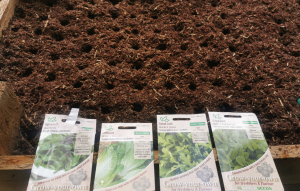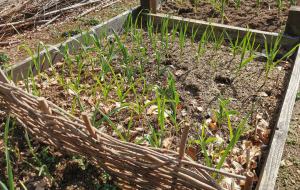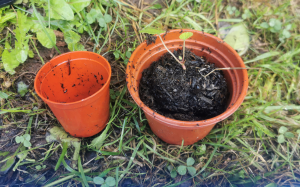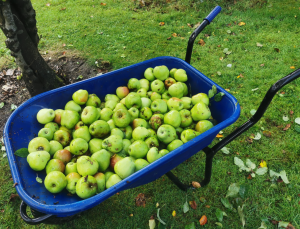
Introduction:
If you are new to growing you may think that seeds can only be sown in spring, and then crops harvested in late summer and autumn, and then there’s nothing to do until the next spring. Well we’re very pleased to tell you that actually autumn and winter can be the busiest time on the allotment and for food growing!
Jobs in October can include planting garlic, turning compost, replenishing wood chip paths, shed repairs, clearing out greenhouses and polytunnels, weeding pretty much everything, and also harvesting the last of the summer crops.
Read the previous articles here:
January / February / March / April / May / June / July / August / September
If you are new to growing your own food and want to have a go, why not start this year? Email us for a free PDF guide to help you! Laura will also help via social media or email – laura.beardsmore@tcv.org.uk
Seeds to Sow in October:
Garlic:
Most guides will tell you to start garlic on the shortest day of the year in December but with experience I have found that mid-October is best for my Birmingham allotment. It also means that the ground is more favourable for planting – it isn’t frozen or flooded – so the garlic can get a head start on growing and developing before the winter properly starts. Buy your garlic from suppliers, we use Kings Seeds, but you can sometimes find packs on the highstreet for example in Wilkos. You can also grow garlic from the veg aisle in shops. Break the bulb into individual cloves and plant them separately, leaving enough room for them to swell into the new garlic bulb. Different garlics need different amounts of room! For example, elephant garlic needs 20cm between cloves, but some varieties only need 10cm.
The garlic will be ready to harvest next July or August, so it needs a long growing season without being disturbed! Make sure you make the hole deep enough for the garlic to go in without pushing it in. Pushing it can damage the bottom where the roots grow. Gently cover them over with compost and firm the ground down. You might want to cover them over with enviromesh or rigid netting to stop the squirrels and birds pulling them out again.
Salad Crops:
You can still sow salad crops, but start to think about protecting them from the elements. You might want to grow them indoors on a windowsill, or use a greenhouse, coldframe or polytunnel. A clear stackable plastic box would also work.
Try lollo rosso lettuce, winter hardy spring onion, radish, rocket, mizuna, spinach, and corn salad (lambs lettuce).
Sow the seeds thinly in rows or scattered in a plant pot. The leaf plants can all be grown in shallow trays on shelves indoors (with a drip tray underneath) but radish and spring onion need room for the roots.
Lettuce:
Semi-cos variety ‘winter density’ can be sown now. Start it under protection as the wet weather at this time of year is perfect for slugs and snails to eat your seedlings.
Root crops:
Turnip and radish can be sown in October. You could also do carrots indoors in deep pots.
Leeks:
Start these indoors and they’ll be ready to plant out in early spring. You could sow these in clean fruit punnets filled with compost, make sure there are holes in the bottom.
Peas and Beans:
Get a head start with winter peas and beans by sowing ‘douce provence’ and ‘meteor’ peas now, and all varieties of broad bean. It is best to start these indoors/under cover and plant them out later (Nov & Dec, or in Jan and Feb). Mice and other animals will eat the seeds if they are direct sown.
Non-Edible Seeds:
Sweet peas can be started in October, again under cover. Use toilet or kitchen roll inner tubes filled with compost – this encourages long and strong roots, and then you can plant the whole cardboard tube. Sweet peas will need to be kept indoors until April when all danger of frost has passed.

Seeds started in an unheated greenhouse in October – rocket, spinach, corn salad, lettuce, spring onion, and peas.
Successional Sowing:
You can keep sowing salad crops every month, but think about protecting them from the elements and the slugs. Indoor seed sowing is the best option at this time of year – use a greenhouse, a polytunnel, windowsills, or clear plastic boxes.
Planting Out in October:
If you have started flowers for next summer, these may need pricking out and potting into bigger pots to see them through the winter. I have potted up my hollyhocks with fresh compost and these should get big and strong enough to survive winter before I plant them out next spring.
Harvesting Food in October:
The last of the autumn fruiting raspberries should be ripe and ready for picking! Best eaten straight off the plant, just check for bugs first.
You can keep cutting salad and chard leaves as and when you need them.
Other crops that can be harvested in October:
- Beetroot
- Turnip
- Radish
- Squash
- Late courgettes
- Polytunnel crops ie tomatoes, aubergine, pepper, cucumber
- Late sweetcorn
- Leeks, carrots, parsnip, swede – pull them up as you need them and leave the rest in the ground
- Kale, chard, cabbage leaves
- Apples
Getting Ready for November:
November is the time to plant onion sets and shallots, so start thinking about where you want to put them! Onions do not like a lot of nitrogen at the roots, so don’t plant them where you have just grown peas or beans.
Cover any unused beds or growing spaces with cardboard and a thick layer of mulch, ready for spring. Good mulch can be manure, compost from your home system, wood chippings, or a combination of all three.
Remember to tag us and share pictures with us on social media – find us on:
And if you want help and advice, why not join our Grow Well, Eat Well group on Facebook?


